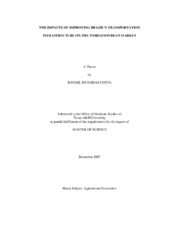| dc.description.abstract | The lack of adequate transportation infrastructure in Brazil has been a bottleneck for the
soybean producers for many years. Moreover, the costly inland transportation incurred
from this bottleneck has resulted in a loss in competitiveness for Brazil compared to
other exporting countries, especially the United States. If transportation costs are
reduced by introducing improved infrastructure, Brazil is expected to increase its
competitiveness in the world soybean market by increasing its exports and producer
revenues. On the other hand, the United States and other significant soybean competing
exporting countries are expected to lose market share as well as producer revenues.
This study uses a spatial equilibrium model to analyze transportation
infrastructure improvements proposed by the Brazilian government vis-à-vis enhance the
nation’s soybean transportation network. The analyzed transportation improvements are:
(i) the development of the Tapajós-Teles Pires waterway; (ii) the completion of the BR-
163 highway; (iii) the construction of the Mortes-Araguaia waterway; (iv) the Ferronorte
railroad expansion to Rondonópolis and the linkage between the city of Rio Verde to
Uberlândia; and (v) the Ferropar railroad expansion to the city of Dourados. The model
specifies the Brazilian inland transportation network and the international ocean shipments. The model divides Brazil into 18 excess supply regions and 8 excess demand
regions. The competing exporting countries are the United States, Argentina, Rest of
South America (Bolivia, Paraguay, and Uruguay), Canada, and India. The importing
countries are composed of China, European Union, Southeast Asia, Mexico, and the
Rest of the World.
Results suggest these proposed transportation improvements yield potential
noteworthy gains to Brazil with producer revenues increasing more than $500 million
and exports increasing by 177 thousand metric tons. Consequently, the world soybean
price declines by $1.16 per metric ton and producer revenues and exports in the United
States fall by 63 thousand metric tons and $104.89 million, respectively. Although the
absolute gains in price, revenues, and exports for Brazil are considerable, they only
represent in relative changes 1.48, 2.35, and 0.32 percent, respectively. Similarly, the
loss in price, revenue, and export value for the United States is also low, declining by
0.23, 0.23, and 0.12 percent, respectively. | en |


